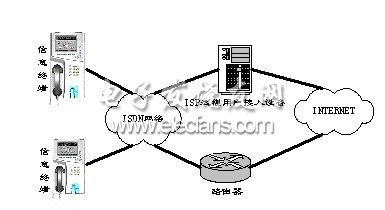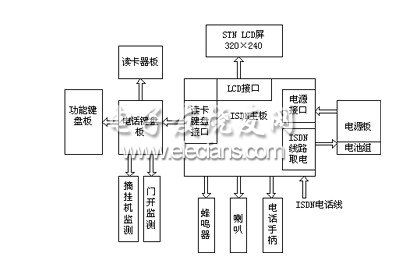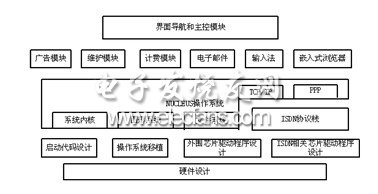The public telephone itself has widely distributed characteristics, and can become a good carrier for accessing the Internet and providing service information. Traditional public telephones can only provide voice services, but they are powerless to access the Internet and provide information services.
This paper designs an information terminal that conforms to the direction of public telephone development. It not only provides all the functions of traditional public telephones, but also provides Internet access services by taking advantage of the ISDN digital network. People can enjoy various functions more convenient than PC access to the public Internet, and they can use information terminals to browse web pages. The information terminal also provides SMTP and POP3 functions. With the Chinese input method and T9 English input method, it is easy to send and receive emails. Telecom operators can easily provide various charging information services through information terminals, which also include various advertisements issued by advertisers.
The access method of the information terminal is shown in Figure 1:

Figure 1: Access method of information terminal
1 The overall design of the information terminal
Information terminals belong to the field of public telephones, and have special requirements in terms of power consumption, access methods, and ease of operation. Therefore, standard embedded system design is adopted.
The processor of the information terminal selects EP7312 in the Soc embedded processor ARM7 series. The processor uses the ARM7TDMI processor core, with 8K bytes of cache memory (CACHE), supports MMU, with 64-way TLB (translaTIon look-aside buffer); write buffer. Ultra-low power consumption (typical) 90mW in 74MHZ working state, 30mW in 18MHZ working state, 10mW in idle state (CPU clock stopped, rest work), <1 mW in suspended state (real-time clock work, rest rest jobs).
The operating system adopts NUCLEUS embedded operating system. NUCLEUS embedded operating system provides source code, users can deeply understand the operation of the underlying kernel, and can modify the system software according to their own special requirements. It uses advanced micro-kernel (Micro-kernel) technology, which has considerable advantages in priority arrangement, task scheduling, task switching and other aspects, and has certain uniqueness in preventing priority inversion. Moreover, it can combine Paradigm, SDS and ATI's own multi-task debugger to form a powerful integrated development environment. In addition to providing a powerful kernel operating system, NUCLEUS also provides a variety of functional modules.
The information terminal uses ISDN to connect to the public Internet. Because the ISDN switch has the capability of remote supply (can provide 1 watt of power), the access terminal does not require an external power supply, and the access method is simple. This is ideal for an alternative to public telephones. Moreover, the ISDN network has stable performance, flexible use and mature technology. Information terminals can make full use of the two B channels of ISDN to provide users with a public Internet access method, and various forms of value-added services can be developed on the basis of this platform.
2 Information terminal hardware design
The information terminal mainly includes a main board, a power board, a card reader board, a telephone keyboard board, a function keyboard board, and an LCD screen.

Figure 2 The overall design of the information terminal
The core of the information terminal hardware is the terminal motherboard, which is responsible for managing keyboard scanning and peripheral status monitoring. The LCD interface provides a 320 & TImes; 240 resolution display screen to display data, images, and interactive information with the user. In addition, since the information terminal belongs to the public telephone system, it also needs to include function modules such as a card reader board, a function keyboard board, door opening and off-hook detection.
This system makes full use of the power supply capacity of the ISDN switch. The power board draws power from the ISDN line and provides + 5V and + 3.3V power to the main board after conversion. It comes with a backup battery to ensure that the ongoing operations and records can be completed when the line is powered off.
2.1 Functional block diagram of the motherboard

Figure 3: Main block diagram
The main board consists of embedded processor (EP7312), FLASH (28F320C3 of INTEL company), SDRAM (W986416DH), U interface control chip (MC145576), sound codec chip (MC145481), ISDN data link control chip in the ISDN reference model (HFC-S +) and other chips.
EP7312 controls FLASH, SDRAM, HFC-S + through the bus. The processor realizes the functions of ISDN call and communication by controlling HFC-S +. MC145576 chip mainly completes the conversion between S / T interface and U interface in the ISDN reference model. The 8M FLASH storage space is integrated on the main board, which is divided into two parts, of which 3M is used as the program space, and the rest is used to store the file system compatible with MS-DOS4. HFC-S + supports B-channel and D-channel advanced data link control (HDLC), and provides GCI bus, FIFO control, etc. MC145481 CODEC chip is a PCM codec chip, which realizes the digitization and reorganization of sound.
The bidirectional overvoltage protection diode BAV99 and short-circuit resistance are added to each line of the keyboard scan of EP7312, which improves the anti-static ability and short-circuit resistance. The clock chip of the main board adopts PCF8563 chip of PHILIPS to prevent vibration.
3 Software design of information terminal
The software of this system is mainly divided into startup code, chip driver program design, transplantation of operating system and ISDN protocol stack, and application program design. The system software structure is shown in Figure 4:

Figure 4: System software structure diagram
3.1 Design of startup code
The startup code is a very important part in the design of the information terminal. It is the first piece of code that the EP7312 processor executes after a cold start and is written with ARM assembly instructions. In this section of the program to perform some necessary initialization tasks, such as the initialization of the interrupt vector table, SDRAM controller initialization, memory management unit (MMU) initialization, and so on.
Set the entry pointer: The startup program must first define the entry pointer, and the entire application has only one entry pointer.
Set the interrupt vector table: ARM7 requires that the interrupt vector table must be set to start at address 0, continuous 8 & TImes; 4 bytes
Spaces are reset, undefined instruction error, software interrupt, prefetch instruction error, data access error, IRQ, FIQ and a reserved interrupt vector.
Owl Clock Moving Eyes,Gear Moving Clock,Cat Clock With Moving Tail,Horse Clock
Guangzhou Huanyu Clocking Technologies Co., Ltd. , https://www.findclock.com